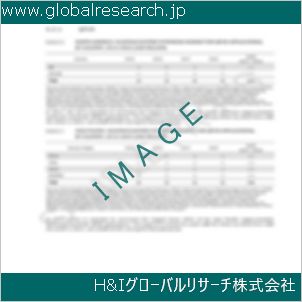Table of Contents
1 Industry Overview of Galliumarsenide
1.1 Definition and Specifications of Galliumarsenide
1.1.1 Definition of Galliumarsenide
1.1.2 Specifications of Galliumarsenide
1.2 Classification of Galliumarsenide
1.3 Applications of Galliumarsenide
1.3.1 Nuclear Application
1.3.2 Non-Nuclear Application
1.4 Industry Chain Structure of Galliumarsenide
1.5 Industry Overview and Major Regions Status of Galliumarsenide
1.5.1 Industry Overview of Galliumarsenide
1.5.2 Global Major Regions Status of Galliumarsenide
1.6 Industry Policy Analysis of Galliumarsenide
1.7 Industry News Analysis of Galliumarsenide
2 Manufacturing Cost Structure Analysis of Galliumarsenide
2.1 Raw Material Suppliers and Price Analysis of Galliumarsenide
2.2 Equipment Suppliers and Price Analysis of Galliumarsenide
2.3 Labor Cost Analysis of Galliumarsenide
2.4 Other Costs Analysis of Galliumarsenide
2.5 Manufacturing Cost Structure Analysis of Galliumarsenide
2.6 Manufacturing Process Analysis of Galliumarsenide
3 Technical Data and Manufacturing Plants Analysis of Galliumarsenide
3.1 Capacity and Commercial Production Date of Global Galliumarsenide Major Manufacturers in 2023
3.2 Manufacturing Plants Distribution of Global Galliumarsenide Major Manufacturers in 2023
3.3 R&D Status and Technology Source of Global Galliumarsenide Major Manufacturers in 2023
3.4 Raw Materials Sources Analysis of Global Galliumarsenide Major Manufacturers in 2023
4 Capacity, Production and Revenue Analysis of Galliumarsenide by Regions, Types and Manufacturers
4.1 Global Capacity, Production and Revenue of Galliumarsenide by Regions 2019-2024
4.2 Global and Major Regions Capacity, Production, Revenue and Growth Rate of Galliumarsenide 2019-2024
4.3 Global Capacity, Production and Revenue of Galliumarsenide by Types 2019-2024
4.4 Global Capacity, Production and Revenue of Galliumarsenide by Manufacturers 2019-2024
5 Price, Cost, Gross and Gross Margin Analysis of Galliumarsenide by Regions, Types and Manufacturers
5.1 Price, Cost, Gross and Gross Margin Analysis of Galliumarsenide by Regions 2019-2024
5.2 Price, Cost, Gross and Gross Margin Analysis of Galliumarsenide by Types 2019-2024
5.3 Price, Cost, Gross and Gross Margin Analysis of Galliumarsenide by Manufacturers 2019-2024
6 Consumption Volume, Consumption Value and Sale Price Analysis of Galliumarsenide by Regions, Types and Applications
6.1 Global Consumption Volume and Consumption Value of Galliumarsenide by Regions 2019-2024
6.2 Global and Major Regions Consumption Volume, Consumption Value and Growth Rate of Galliumarsenide 2019-2024
6.3 Global Consumption Volume and Consumption Value of Galliumarsenide by Types 2019-2024
6.4 Global Consumption Volume and Consumption Value of Galliumarsenide by Applications 2019-2024
6.5 Sale Price of Galliumarsenide by Regions 2019-2024
6.6 Sale Price of Galliumarsenide by Types 2019-2024
6.7 Sale Price of Galliumarsenide by Applications 2019-2024
6.8 Market Share Analysis of Galliumarsenide by Different Sale Price Levels
7 Supply, Import, Export and Consumption Analysis of Galliumarsenide
7.1 Supply, Consumption and Gap of Galliumarsenide 2019-2024
7.2 Global Capacity, Production, Price, Cost, Revenue, Supply, Import, Export and Consumption of Galliumarsenide 2019-2024
7.3 USA Capacity, Production, Price, Cost, Revenue, Supply, Import, Export and Consumption of Galliumarsenide 2019-2024
7.4 EU Capacity, Production, Price, Cost, Revenue, Supply, Import, Export and Consumption of Galliumarsenide 2019-2024
7.5 China Capacity, Production, Price, Cost, Revenue, Supply, Import, Export and Consumption of Galliumarsenide 2019-2024
7.6 Japan Capacity, Production, Price, Cost, Revenue, Supply, Import, Export and Consumption of Galliumarsenide 2019-2024
8 Major Manufacturers Analysis of Galliumarsenide
8.1 Manufacturer One
8.1.1 Company Profile
8.1.2 Product Picture and Specifications
8.1.2.1 Type I
8.1.2.2 Type II
8.1.2.3 Type III
8.1.3 Capacity, Production, Price, Cost, Gross and Revenue
8.1.4 Contact Information
8.2 Manufacturer Two
8.2.1 Company Profile
8.2.2 Product Picture and Specifications
8.2.2.1 Type I
8.2.2.2 Type II
8.2.2.3 Type III
8.2.3 Capacity, Production, Price, Cost, Gross and Revenue
8.2.4 Contact Information
8.3 Manufacturer Three
8.3.1 Company Profile
8.3.2 Product Picture and Specifications
8.3.2.1 Type I
8.3.2.2 Type II
8.3.2.3 Type III
8.3.3 Capacity, Production, Price, Cost, Gross and Revenue
8.3.4 Contact Information
8.4 Manufacturer Four
8.4.1 Company Profile
8.4.2 Product Picture and Specifications
8.4.2.1 Type I
8.4.2.2 Type II
8.4.2.3 Type III
8.4.3 Capacity, Production, Price, Cost, Gross and Revenue
8.4.4 Contact Information
8.5 Manufacturer Five
8.5.1 Company Profile
8.5.2 Product Picture and Specifications
8.5.2.1 Type I
8.5.2.2 Type II
8.5.2.3 Type III
8.5.3 Capacity, Production, Price, Cost, Gross and Revenue
8.5.4 Contact Information
…
9 Marketing Trader or Distributor Analysis of Galliumarsenide
9.1 Marketing Channels Status of Galliumarsenide
9.2 Traders or Distributors with Contact Information of Galliumarsenide by Regions
9.3 Ex-work Price, Channel Price and End Buyer Price Analysis of Galliumarsenide
9.4 Regional Import, Export and Trade Analysis of Galliumarsenide
10 Industry Chain Analysis of Galliumarsenide
10.1 Upstream Major Raw Materials Suppliers Analysis of Galliumarsenide
10.1.1 Major Raw Materials Suppliers with Contact Information Analysis of Galliumarsenide
10.1.2 Major Raw Materials Suppliers with Supply Volume Analysis of Galliumarsenide by Regions
10.2 Upstream Major Equipment Suppliers Analysis of Galliumarsenide
10.2.1 Major Equipment Suppliers with Contact Information Analysis of Galliumarsenide
10.2.2 Major Equipment Suppliers with Product Pictures Analysis of Galliumarsenide by Regions
10.3 Downstream Major Consumers Analysis of Galliumarsenide
10.3.1 Major Consumers with Contact Information Analysis of Galliumarsenide
10.3.2 Major Consumers with Consumption Volume Analysis of Galliumarsenide by Regions
10.4 Supply Chain Relationship Analysis of Galliumarsenide
11 Development Trend of Analysis of Galliumarsenide
11.1 Capacity, Production and Revenue Forecast of Galliumarsenide by Regions and Types
11.1.1 Global Capacity, Production and Revenue of Galliumarsenide by Regions 2024-2029
11.1.2 Global and Major Regions Capacity, Production, Revenue and Growth Rate of Galliumarsenide 2024-2029
11.1.3 Global Capacity, Production and Revenue of Galliumarsenide by Types 2024-2029
11.2 Consumption Volume and Consumption Value Forecast of Galliumarsenide by Regions, Types and Applications
11.2.1 Global Consumption Volume and Consumption Value of Galliumarsenide by Regions 2024-2029
11.2.2 Global and Major Regions Consumption Volume, Consumption Value and Growth Rate of Galliumarsenide 2024-2029
11.2.3 Global Consumption Volume and Consumption Value of Galliumarsenide by Types 2024-2029
11.2.4 Global Consumption Volume and Consumption Value of Galliumarsenide by Applications 2024-2029
11.3 Supply, Import, Export and Consumption Forecast of Galliumarsenide
11.3.1 Supply, Consumption and Gap of Galliumarsenide 2024-2029
11.3.2 Global Capacity, Production, Price, Cost, Revenue, Supply, Import, Export and Consumption of Galliumarsenide 2024-2029
11.3.3 USA Capacity, Production, Price, Cost, Revenue, Supply, Import, Export and Consumption of Galliumarsenide 2024-2029
11.3.4 EU Capacity, Production, Price, Cost, Revenue, Supply, Import, Export and Consumption of Galliumarsenide 2024-2029
11.3.5 China Capacity, Production, Price, Cost, Revenue, Supply, Import, Export and Consumption of Galliumarsenide 2024-2029
11.3.6 Japan Capacity, Production, Price, Cost, Revenue, Supply, Import, Export and Consumption of Galliumarsenide 2024-2029
12 New Project Investment Feasibility Analysis of Galliumarsenide
12.1 New Project SWOT Analysis of Galliumarsenide
12.2 New Project Investment Feasibility Analysis of Galliumarsenide
13 Conclusion of the Global Galliumarsenide (CAS 1303-00-0) Industry 2024 Market Research Report
| ※参考情報 ヒ化ガリウム(Gallium Arsenide, GaAs)は、化学式GaAsで表される半導体材料です。ガリウム(Ga)とヒ素(As)の化合物であり、特に電子工学や光通信技術において広く使用されています。ヒ化ガリウムは、シリコンと並ぶ重要な半導体材料の一つであり、特にその優れた電子的および光学的特性から、様々な分野で利用されています。 ヒ化ガリウムの特徴としては、まず高い電子移動度が挙げられます。これは、電子が結晶内を移動する際の抵抗が少ないことを意味し、高速なデバイスの製造に適しています。また、バンドギャップが1.4電子ボルト(eV)と比較的広いため、高い温度でも動作します。これにより、高温環境下でも性能を維持できるため、宇宙産業や高温環境における用途においても重宝されています。 ヒ化ガリウムはまた、発光特性にも優れており、特に赤外線領域での発光デバイスにおいて重要な役割を果たしています。半導体レーザーや光検出器、光ファイバー通信システムなどで利用されています。この特性は、通信分野でのデータ伝送速度を向上させる要因の一つとして寄与しています。 ヒ化ガリウムにはいくつかの種類があり、主にその結晶構造に基づいて分類されます。一般的に、結晶構造は立方晶系(ズブロ型)と六方晶系(ワールズ型)に分類されます。特に立方晶系のヒ化ガリウムは、デバイス構造を作成する際に最も一般的に使用されます。 ヒ化ガリウムの用途は幅広く、電子デバイスや光デバイスなど、多岐にわたります。特に、マイクロ波デバイスや高周波回路においては、良好な特性を持ち、高効率のアンプや発振器などで使用されています。また、太陽光発電においては、ヒ化ガリウムを用いた高効率太陽電池が開発されており、特に宇宙用途での効率的なエネルギー収集が可能となっています。 さらに、ヒ化ガリウムは光通信においても重要な役割を果たしており、光ファイバー通信システムでの広帯域通信を実現するために利用されます。高速なデータ伝送が求められる現代社会において、ヒ化ガリウムベースのデバイスが必要とされている理由の一つでもあります。 関連技術としては、バイオセンサーやメモリデバイス、自動運転技術におけるLiDAR(光検出および距離測定技術)など、多岐にわたります。ヒ化ガリウムの特性を活かした新しい技術の研究が進められており、その応用範囲は今後も広がっていくと考えられています。 ヒ化ガリウムは、その特性のおかげで、シリコンでは成し得なかった高性能のデバイスを実現可能にしています。特に、スマートフォンやタブレットなどの通信機器、高効率な太陽電池、さらには先進的な医療機器やセンサー技術まで、さまざまな分野での利用が期待されています。今後も、ヒ化ガリウムに関する技術革新が進むことで、新しい応用の可能性が開かれることが予想されます。 最後に、ヒ化ガリウムの生産に際しては、環境への配慮が求められます。ヒ素を含む材料であるため、その取り扱いや廃棄には厳重な管理が不可欠です。環境影響評価や適切なリサイクル方法の確立が、今後の課題として挙げられます。ヒ化ガリウムを利用した技術が持続可能であるためには、環境保護の観点からも配慮が必要です。 以上のように、ヒ化ガリウムはその特性から、半導体業界において重要な役割を果たしており、今後もその利用は拡大していくことが期待されます。技術革新が進む中で、新たな応用や市場が生まれ、私たちの生活に寄与することになるでしょう。ヒ化ガリウムの研究開発が進展することを期待しています。 |
❖ 免責事項 ❖
http://www.globalresearch.jp/disclaimer












